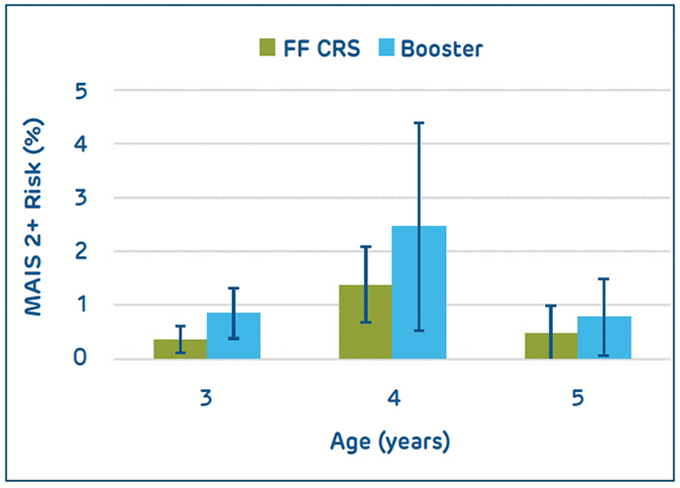Principal Investigator: Julie Mansfield, PhD, The Ohio State University
WHAT WAS THE PURPOSE OF THIS PROJECT?
Best practice recommendations for CRS are partly determined by studying injury outcomes using federally available crash databases. While these sources have been studied for rear-facing versus forward-facing (FF) CRS, the literature is lacking information for the transition from a FF CRS to a belt-positioning booster (BPB) seat. This is a gap that crash testing cannot easily fill, as ATDs restrained in these two restraint types may not be able to discriminate these nuanced differences. This project’s aim was to analyze this crucial transition point to ascertain if there are age, height, or weight milestones that might indicate the safest time to move from a FF CRS to a BPB.
We looked at injury outcome data for children near the FF CRS to BPB transition size. Data were analyzed from the two systems within the National Automotive Sampling System (NASS) – the General Estimates System (GES), which pulls from police reports, and the Crashworthiness Data System (CDS), which contains detailed data on a sample of crashes.
WHAT DID YOU FIND?
We found that, as expected, younger and smaller children tended to be seated in FF CRS, while older and larger children tended to be restrained in BPB. The overall risk of a child receiving a moderate to severe injury was typically less than 2 or 3 percent in both restraint types.
Due to limitations with the data, including the number of cases and level of detail across both sub-sets of the NASS database, we were not able to determine with statistical certainty if there is a safety benefit of a child of this age and size using one type of restraint over another.
WHAT WERE YOUR FINDINGS?
The way in which restraint systems and restraint design have changed was really interesting. We tested a forward-facing convertible CRS and a high-back booster and found that in both these conditions having a modern passenger air bag is more beneficial to the child than not having one in frontal impacts and frontal off-set impacts. However, these findings were very specific to the vehicle make, model, and crash conditions.
Due to limitations with the data, including the number of cases and level of detail across both sub-sets of the NASS database, we were not able to determine with statistical certainty if there is a safety benefit of a child of this age and size using one type of restraint over another.
WHAT ARE THE IMPLICATIONS FOR THESE FINDINGS?
The results of this study, which looked at the most recent federal data available, suggest that other sources are needed to answer the research question with certainty. Both types of restraints appear to work well since the risk of injury was low for both. Best practice guidelines currently recommend using FF CRS for as long as possible because children have less freedom of movement to wiggle out of the ideal position in this type of CRS.
Project Team Member
Rakshit Ramachandra, PhD, The Ohio State University
Student
Li Li, The Ohio State University
IAB Mentors
Emily Thomas, Consumer Reports; Suzanne Johansson, General Motors Holdings LLC; Mark LaPlante, Graco Children’s Products Inc.; Nick Rydberg, Minnesota HealthSolutions; Jason Stammen, National Highway Traffic Safety Administration; Julie Kleinert, Technical Advisor; Uwe Meissner, Technical Advisor


